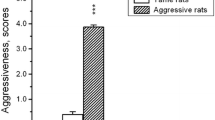Abstract
The agonistic behavior of inexperienced pairs of agouti male mice was determined by counting the bites received from and delivered to the opponent within 24 h. The first 10 min of agonistic encounters was recorded by videotape to analyze the frequency and duration of 10 behavioral traits. Each pair consisted of two F1 males from the cross of (101/C3H)♂ x NMRI♀, one of which (test male) was derived from a father carrying a reciprocal translocation, T(10,13), in the heterozygous state, while the other (standard opponent) stemmed from a chromosomally normal father of the same origin. Since the offspring of a heterozygous translocation are segregating into chromosomally normal and translocation mice, the test male was either chromosomally normal or a carrier of the translocation in the heterozygous state. Apart from the translocation, all males were of the same genotypic constitution. Comparing the differences between translocation carriers and chromosomally normal mice relative to their standard opponent, significantly more winners than losers were found among the translocation carriers. The differences of 10 behavioral traits between the test male and his opponent revealed significantly more contacts, pursuits, and attacks and significantly fewer defense and flight responses of the test males when this was a carrier of the heterozygous translocation, T(10,13).
Similar content being viewed by others
References
Adler, I. D. (1978). The cytogenetic heritable translocation test.Biol. Zbl. 97:441–451.
Brewen, J. G., Preston, R. J., and Luippold, H. E. (1979). Radiation-induced translocations in spermatogonia. III. Effect of long-term chronic exposure to gamma rays.Mutat. Res. 61:405–409.
Busser, J., Zweep, A., and van Oortsmerssen, G. A. (1974). Variability in the aggressive behavior ofMus musculus domesticus, its possible role in population structure. In van Abeelen, J. H. F. (ed.),The Genetics of Behaviour, North-Holland, Amsterdam-Oxford, American, Elsevier, New York, pp. 185–199.
Buul, P. P. W. v. (1978). Dose-response relationship for X-ray induced reciprocal translocations in rhesus monkey spermatogonia.International Congress of Genetics, Moscow, 1978, Abstracts, Part 2, Sect. 21–32, p. 213.
Cattanach, B. M., Heath, C. M., and Tracey, J. M. (1976). Translocation yield from the mouse spermatogonial stem cell following fractionated X-ray treatments: influence of unequal fraction size and of increasing fractionation interval.Mutat. Res. 35:257–268.
Collins, R. A. (1970). Aggression in mice selectively bred for brain weight.Behav. Genet. 1:169.
Eibl-Eibesfeldt, I. (1950). Beiträge zur Biologie der Haus- und der Ährenmaus nebst einigen Beobachtungen an anderen Nagern.Z. Tierpsychol. 7:558–567.
Eibl-Eibesfeldt, I. (1958). Das Verhalten der Nagetiere.Handbuch der Zoologie, Bd. 8, Lief. 12, De Gruyter, Berlin, pp. 1–88.
Hecht, F. (1977). The non-randomness of human chromosome abnormalities. In Hook, E. B., and Porter, I. H. (eds.),Population Genetics: Studies in Humans, Academic Press, New York, pp. 237–250.
Krishna, M., and Generoso, W. (1977). X-ray-induction of heritable translocations in mouse dictyate oocytes.Genetics 86:s36-s37 (abstract).
Levine, C., Diakow, C. A., and Barsel, G. E. (1965). Interstrain fighting in male mice.Anim. Behav. 13:52–58.
Patil, S. R., Lubs, H. A., Kimberling, W. J., Brown, J., Cohen, M., Gerald, P., Hecht, F., Moorhead, P., Myrianthopoulos, N., and Summitt, R. L. (1977). Chromosomal abnormalities ascertained in a collaborative survey of 4342 seven and eight year old children: Frequency, phenotype and epidemiology. In Hook, E. B., and Porter, I. H. (eds.),Population Cytogenetics: Studies in Humans, Academic Press, New York, pp. 103–131.
Rowley, J. D. (1977). Population cytogenetics of leukemia. In Hook, E. B., and Porter, I. H. (eds.),Population Cytogenetics: Studies in Humans, Academic Press, New York, pp. 189–216.
Sachs, L. (1973).Angewandte Statistik: Planung und Auswertung, Methoden und Modelle, Heidelberg, Berlin.
Schröder, J. H. (1977). Testing mutagenicity in mice by scoring agonistic behaviour of males.Ber. nat.-med. Ver. Innsbruck 64:171–177.
Schröder, J. H. (1980). Increase in aggressiveness of male mice after irradiation of paternal spermatozoa with 600 R of γ-rays as dependent on fertility.Behav. Genet. 10:387–400.
Searle, A. G., and Beechey, C. V. (1974). Cytogenetic effects of X-rays and fission neutrons in female mice.Mutat. Res. 24:171–186.
Siegel, S. (1956).Nonparametric Statistics for the Behavioral Sciences, McGraw-Hill, Kogakusha, Tokyo.
Author information
Authors and Affiliations
Additional information
Dedicated to Nobel Laureate Professor Dr. Dr. Dr. h.c. mult. Konrad Lorenz on the occasion of his 80th birthday.
Rights and permissions
About this article
Cite this article
Schröder, J.H., Otten, IS. Increase in aggressiveness of male mice carrying a reciprocal translocation, T(10,13), in the heterozygous state. Behav Genet 15, 43–51 (1985). https://doi.org/10.1007/BF01071931
Received:
Accepted:
Issue Date:
DOI: https://doi.org/10.1007/BF01071931




